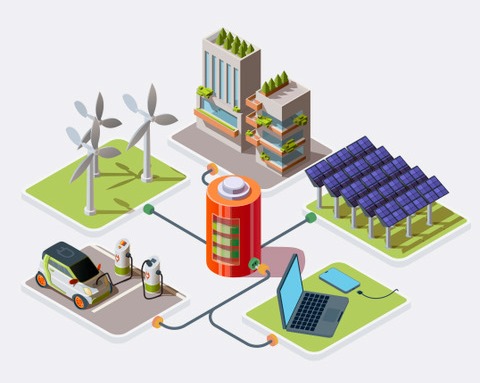
A few years ago, flush with our new toy, two members of our Energy team took a photo of Moorlands House on a Sunday in midwinter in a cheeky bid to draw attention to the building's heat loss.
To their credit, SMDC responded by buying their own heat camera to use on testing their buildings. This was a popular item on display at our recent Youth Conference.
Better still, Cllr Nigel Yates, Cabinet Member for Climate Change and Environment, when speaking to the students used the antiquated and hard-to-control heating system in the building as a good analogy for the planet's problem with overheating and the difficulties involved in bringing temperatures down.
Now that temperatures are dropping, we are making our camera available again for those who want to test the temperature leakiness (or otherwise) of their own homes.
To register an interest, please fill in the form below.
REGISTER HERE

National Planning Policy is now strongly supportive of renewable energy but, together with Local Plans, that policy attempts to ensure that solar farms, wind turbines or battery storage systems are located in ‘the right places’. But the subject raises legitimate concerns, and this brief note explains in outline the factors that go into a planning decision. These factors are called ‘material’; other issues are ‘non-material’; I touch on some of these wider issues, too.
Renewable Energy in the Moorlands
In recent years the Moorlands has seen a significant number of renewable applications. The (non-definitive) map above was created by Moorlands Climate Action to help keep track. The map shows how closely projects follow the main 400kV power line from the Trent Valley (where the old coal-fired power stations were) to Macclesfield and beyond. Renewable energy typically needs a close connection to the National Grid.

Good weather and the rapid build-up of solar capacity meant that the UK generated more clean energy from the sun by mid-August than it did in the whole of last year. For a short period on July 8th, solar met 40% of the UK’s total needs; between gloomy January and sun-drenched July the average contribution ran at around 10%. But events elsewhere have shown the perils of building renewable generation capacity without accompanying investment in the grid infrastructure. In April, 58m Spanish and other Iberian customers were left without power for up to five hours when the grid shut down. The precise cause and sequence of events are still fiercely contested but no-one doubts that inadequate storage and voltage frequency stabilisation capacity was at the root of the crash.
The UK’s main bottleneck is transmission – crudely, moving power from where it is made (such as Scottish wind farms) to where it is used (further south in England). Last year, wind farms were paid to switch off for 13% of the time they should have generated power, according to the grid operator NESO. That costs consumers £400m. It’s to eliminate those costs that the Grid is developing a number of large-scale pylon and cable projects – the nearest to the Moorlands is in Derbyshire’s Amber Valley. But storage is also a crucial part of the equation, helping even out the supply and demand of intermittent renewable energy over time. It also helps keep the Grid running within a tiny band of the required 50Hz frequency.

Moorlands Climate Action hosted a Beginners’ Guide to Community Energy in May in what we hope is the start of the journey to having a project in the Moorlands. The session was led by Mike Kinghan, MBE, chair of award-winning Staffordshire Community Energy (SCE).
Mike outlined SCE’s work so far, which ranged from installing solar panels on council-owned housing to a major project with the University Hospitals of North Midlands Trust at the Royal Stoke. Besides providing the hospital with clean energy at slightly below market price, the project also throws off a financial surplus. This money is then invested in a programme run by Beat the Cold.
Over 500 hospital patients have now been given advice and assistance on reducing their energy costs, obtaining new boilers and other improvements, increasing warmth, reducing fuel debts and accessing benefits that are available to them.
Most community energy programmes are considerably smaller scale than this and Mike outlined the variety of options. They could range from a single building with solar PV to a wind turbine that serves a particular village. The Congleton Hydro scheme, for example, is based on a hydro scheme in the Havannah area of that town and the power generated is used by one single user, the local Siemens factory.
 Slightly warmer weather and bluer skies may be making some of us more optimistic, despite all the doom and gloom in the media. It’s good to hear one encouraging bit of news from the Energy and Climate Intelligence Unit - that compared with 10 years ago climate science scepticism has almost entirely disappeared from the opinion pages of British newspapers. The veteran environment correspondent, Geoffrey Lean, also drew attention to positive responses in polls and criticised newspapers for failing to keep up with their readers’ views. That’s not to ignore the extremes of some social media but we progress one step at a time.
Slightly warmer weather and bluer skies may be making some of us more optimistic, despite all the doom and gloom in the media. It’s good to hear one encouraging bit of news from the Energy and Climate Intelligence Unit - that compared with 10 years ago climate science scepticism has almost entirely disappeared from the opinion pages of British newspapers. The veteran environment correspondent, Geoffrey Lean, also drew attention to positive responses in polls and criticised newspapers for failing to keep up with their readers’ views. That’s not to ignore the extremes of some social media but we progress one step at a time.
In a perfect world, we would be forging ahead in the Moorlands with our own community energy scheme. We’ve reported previously on such schemes and the difficulties in getting them established. Nevertheless, with changing attitudes we think it’s an idea we should keep alive, especially as we’re well placed here for small-scale wind energy and our MP has told us she would not be opposed to a community project. Encouragingly, a very recent YouGov poll shows widespread public support for the creation of community owned, renewable energy projects. Maybe if we keep talking about these, people with the will and motivation to help make it happen will emerge. We can but hope.
In the meantime,...
 Now that temperatures have dropped, we've been able to lend our camera out to members, not just to get feedback from them but also to develop a lending approach that works for both us and them.
Now that temperatures have dropped, we've been able to lend our camera out to members, not just to get feedback from them but also to develop a lending approach that works for both us and them.
So far, it's been going well. We asked potential borrowers to register an interest and then got back to them with a selection of dates for collection and return. At present we're working on Tuesdays and Saturdays for collection, with the camera being returned in time for the next collection date. Collection is usually from the Foxlowe at a mutually agreed time but other locations can be negotiated.
On collection, we introduce users to the camera and show them how to download the associated app. This generally requires a relatively new smart phone, probably no more than five years old - we're learning about the different phones as we go. Usually at least one person in a household has a suitable phone or one that can be borrowed or, if all else fails, we can visit.
- Renewable Energy Projects in the Moorlands - provisional map
- Community Energy in the Moorlands?
- Heat Network Zoning for Moorlands Towns?
- Trialling Our Thermal Camera
- Thermal Images of a 19th Century Moorlands Hill Cottage
- Winter Warming
- Thermal Camera
- Energy Day Report
- Energy Day 2023
- Moorlands Energy Day is Powering Up!
- Keeping Warm This Winter
- First Ever Energy Fair in the Moorlands
